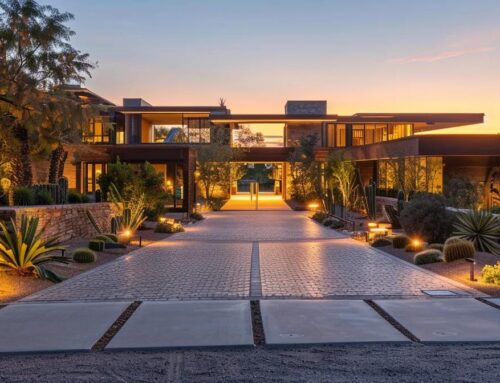
Are you struggling to keep your Homer Glen garden thriving in the summer heat? This guide offers practical tips for effective summer plant care tailored to our local climate. We’ll cover smart watering strategies, pest control, and plant selection to help your garden flourish. By following these methods, you’ll maintain a vibrant, healthy landscape that can withstand summer challenges and bring beauty to your outdoor space.
Key Takeaways
- We tailor watering strategies to Homer Glen’s climate and each plant’s unique needs
- Natural pest control methods and companion planting protect gardens without harmful chemicals
- We select heat-tolerant and native plants for resilient summer landscapes in Homer Glen
- Proper pruning techniques and timing promote healthy growth and continuous blooming
- Sustainable practices like composting and rainwater collection create eco-friendly, thriving gardens
Watering Strategies for Summer Plant Care in Homer Glen

We understand the challenges of summer plant care in Homer Glen. Our strategies cover watering needs for various plants, scheduling based on weather, and using mulch to retain soil moisture. We’ll guide you on monitoring for over or underwatering, implementing drip irrigation, and timing your watering. These methods help protect your garden from insects and deer while promoting healthy agriculture.
Understand the Watering Needs of Various Plant Types
At Bret mar Landscape, we recognize that different plants have unique watering requirements in Homer Glen’s natural environment. We consider factors like soil type, sun exposure, and plant species to tailor our watering strategies for each landscape.
Our expertise extends to various plant types, from drought-resistant perennials to water-loving bulbs. We carefully monitor each plant’s needs, adjusting our techniques to prevent pest issues and ensure optimal growth in your garden.
Develop a Watering Schedule Based on Weather Conditions
We create custom watering schedules based on Homer Glen’s weather patterns to ensure optimal plant health and beauty. Our approach considers factors like temperature, rainfall, and humidity to adjust irrigation frequency and duration. This tailored method promotes efficient water use and supports healthy seed germination.
We monitor local weather forecasts daily to fine-tune our watering strategies. This allows us to adapt quickly to changing conditions, whether it’s a heatwave or an unexpected rainy spell. Our proactive approach helps maintain lush landscapes and thriving spruce trees throughout the summer months:
- Daily weather monitoring
- Adjusting watering frequency
- Modifying irrigation duration
- Adapting to temperature changes
- Accounting for rainfall patterns
Apply Mulch to Retain Moisture in Garden Beds
We apply mulch to garden beds in Homer Glen to retain moisture and reduce watering frequency. This technique helps prevent diseases and maintains optimal soil pressure, benefiting plants even in challenging conditions like those found in Utah or Oklahoma.
Our mulching approach creates a protective barrier that keeps roots cool and moist. We carefully select and apply organic materials that break down over time, enriching the soil and promoting healthy plant growth in your garden.
Monitor for Signs of Overwatering or Underwatering
We closely monitor our clients’ gardens for signs of overwatering or underwatering, which is crucial for maintaining healthy plants and preventing pest issues. Our team checks soil moisture levels regularly, paying special attention to areas near hardscaping features and maple trees, which may have unique watering needs.
When we spot yellowing leaves or wilting, we adjust our watering strategies promptly. We also consider factors like Caribbean-inspired plant selections and recent pruning activities, which can impact a plant’s water requirements. Our proactive approach helps ensure your garden thrives throughout the summer.
Use Drip Irrigation for Efficient Water Usage
We implement drip irrigation systems for efficient water usage in Homer Glen gardens. This method delivers water directly to plant roots, reducing evaporation and conserving soil moisture. Our systems are designed with insights from Stanford University research on leaf water uptake, ensuring optimal hydration for your plants.
Our drip irrigation setups use durable plastic components that withstand outdoor conditions. We integrate these systems seamlessly into your outdoor design ideas, creating a functional and aesthetically pleasing landscape. This approach allows for precise water control, benefiting both your plants and the environment:
- Targeted root-zone watering
- Reduced water waste
- Improved plant health
- Customizable to various garden layouts
- Easy maintenance and adjustments
Time Your Watering to Avoid the Hottest Parts of the Day
We schedule watering during the cooler parts of the day to maximize effectiveness during the growing season. Early morning or late evening watering reduces evaporation, allowing plants to absorb more moisture. This strategy supports hummingbird-friendly gardens and helps maintain our plant database for optimal care.
Our team uses efficient watering techniques, including properly positioned hoses to target roots directly. We’re mindful of plant toxicity when selecting watering methods, ensuring safe practices for all garden varieties. Our approach promotes healthy growth while conserving water:
- Early morning watering (before 10 AM)
- Evening watering (after 6 PM)
- Targeted root zone irrigation
- Adjusting for plant-specific needs
- Monitoring soil moisture levels
With plants quenched, it’s time to feed. Let’s dig into fertilizers and give your garden a boost.
Choosing the Right Fertilizers for Your Summer Garden

We know selecting the right fertilizers is crucial for your summer garden’s success. Our expertise in landscape basics helps us identify nutrient needs for different plant species, choose between organic and chemical options, and apply fertilizers correctly. We’ll guide you on application frequency, soil quality assessment, and recognizing nutrient deficiencies, ensuring your garden thrives while supporting local wildlife.
Identify Nutrient Requirements for Different Plants
At Bret-Mar Landscape, we identify the unique nutrient requirements for different plants in Homer Glen gardens. We consider factors like soil type, pH levels, and plant species to determine the right balance of nitrogen, phosphorus, and potassium. Our approach ensures optimal growth while minimizing the need for pesticides.
As your personal gardener, we tailor fertilizer applications to each plant’s needs. We use OpenStreetMap data to understand local soil conditions and adjust our nutrient strategies accordingly. Our email client keeps you updated on your garden’s health and any fertilizer adjustments we make:
- Soil pH testing
- Custom nutrient blends
- Seasonal fertilizer schedules
- Organic matter incorporation
- Micronutrient supplementation
Select Organic Versus Chemical Fertilizers Wisely
We carefully select between organic and chemical fertilizers for your lawn and garden care. Our approach balances effective weed control with nurturing healthy soil ecosystems. For areas near patios and fire pits, we often opt for organic options to ensure safe outdoor enjoyment.
Our lawn care services include tailored fertilizer applications based on your landscape‘s specific needs. We consider factors like soil composition, plant types, and local climate when choosing between organic and synthetic nutrients. This careful selection process supports robust plant growth while minimizing environmental impact:
- Soil testing for nutrient deficiencies
- Custom fertilizer blends
- Integrated weed management
- Safe application near outdoor living spaces
- Environmentally conscious choices
Learn the Correct Application Methods for Fertilizers
We apply fertilizers with precision, tailoring our lawn care service to each yard’s unique needs. Our knowledge of proper application techniques ensures even distribution and optimal nutrient absorption for your shrubs and plants. We consider factors like soil type, plant species, and local climate to determine the best application methods.
Our team prioritizes accessibility when applying fertilizers, ensuring all areas of your garden receive proper care. We use specialized equipment and techniques to reach difficult spots, promoting uniform growth across your yard. Our careful approach minimizes runoff and maximizes the benefits of fertilization for your landscape.
Understand the Frequency of Fertilizer Application in Summer
We understand the importance of proper fertilizer timing in Homer Glen’s summer landscaping. Our Illinois-based services include carefully scheduled applications tailored to your zip code’s climate and soil conditions. We typically recommend fertilizing every 6-8 weeks during the growing season, adjusting based on your landscape‘s specific needs and architecture.
Our landscaping expertise helps us determine the optimal frequency for fertilizer application. We consider factors like plant types, soil quality, and weather patterns to create a custom feeding schedule. This approach ensures your garden receives the right nutrients at the right time, promoting healthy growth and vibrant blooms throughout the summer months.
Assess Soil Quality to Guide Fertilizer Choices
We assess soil quality in Homer Glen gardens to guide our fertilizer choices effectively. Our team conducts thorough soil tests to determine pH levels, nutrient content, and organic matter, allowing us to tailor fertilizer applications precisely. This approach helps us minimize surface runoff and protect local water sources.
Our soil quality assessments also consider factors like drainage and compaction, which affect nutrient uptake. We use this information to select appropriate fertilizers and adjust outdoor lighting placement, ensuring optimal growing conditions for your plants while promoting environmental sustainability.
Recognize Signs of Nutrient Deficiencies in Plants
We recognize signs of nutrient deficiencies in Homer Glen gardens by closely observing leaf color, growth patterns, and overall plant health. Our experienced team quickly identifies yellowing leaves, stunted growth, or unusual discoloration, allowing us to address deficiencies promptly and maintain your garden’s vitality.
Our expertise in plant nutrition helps us differentiate between various deficiencies, such as nitrogen, phosphorus, or potassium shortages. We use this knowledge to adjust our fertilizer choices and application methods, ensuring your plants receive the specific nutrients they need for optimal growth and bloom production.
The plants drank deep. Now they face new foes.
Protecting Plants From Summer Pests and Diseases

We protect Homer Glen gardens from summer pests and diseases using natural methods and companion planting. Our approach includes identifying common pests, monitoring for early disease signs, and creating organic remedy schedules. We assess environmental factors affecting outbreaks to ensure your plants thrive throughout the season.
Implement Natural Pest Control Methods for Gardens
We implement natural pest control methods in Homer Glen gardens to protect plants without harmful chemicals. Our approach includes introducing beneficial insects like ladybugs and praying mantises, which prey on common garden pests. We also use companion planting techniques, placing aromatic herbs near vulnerable plants to deter unwanted insects.
Our natural pest control strategies extend to physical barriers and traps. We install row covers to shield plants from flying insects and set up sticky traps to capture crawling pests. These methods effectively manage pest populations while maintaining a healthy garden ecosystem:
- Introduce beneficial insects
- Implement companion planting
- Install physical barriers
- Set up sticky traps
- Use organic repellents
Identify Common Summer Pests in Homer Glen
We identify common summer pests in Homer Glen gardens to protect your plants effectively. Our team regularly inspects for Japanese beetles, aphids, and tomato hornworms, which often appear during warmer months. We also watch for signs of spider mites and whiteflies, especially on ornamental plants and vegetables.
Our expertise helps us spot early infestations of scale insects and mealybugs, which can quickly spread in summer conditions. We educate our clients on recognizing pest damage, such as chewed leaves or distorted growth, to catch problems early. This proactive approach allows us to implement targeted control measures promptly.
Use Companion Planting to Deter Pests Effectively
We use companion planting to deter pests effectively in Homer Glen gardens. Our approach pairs compatible plants that naturally repel insects or attract beneficial predators. For example, we plant marigolds near tomatoes to deter nematodes and whiteflies, while basil helps protect against mosquitoes and flies.
Our companion planting strategies create diverse garden ecosystems that naturally resist pest infestations. We carefully select plant combinations that support each other’s growth while discouraging harmful insects. This method reduces the need for chemical pesticides and promotes a healthier garden environment:
- Pairing aromatic herbs with vegetables
- Planting flowers that attract beneficial insects
- Using trap crops to divert pests
- Creating barriers with pest-repelling plants
- Implementing intercropping techniques
Monitor for Early Signs of Plant Diseases
We vigilantly monitor Homer Glen gardens for early signs of plant diseases. Our team conducts regular inspections, looking for symptoms like leaf spots, wilting, or unusual discoloration. We pay close attention to high-risk areas, such as densely planted beds or locations with poor air circulation.
Our proactive approach allows us to identify and address potential issues before they spread. We educate our clients on common disease indicators specific to their plant varieties, empowering them to participate in early detection. This collaborative effort helps maintain healthier gardens throughout the summer season:
- Regular plant inspections
- Identification of disease symptoms
- Focus on high-risk areas
- Client education on disease indicators
- Prompt action on potential issues
Create a Spraying Schedule for Organic Remedies
We create customized spraying schedules for organic remedies in Homer Glen gardens. Our approach considers plant types, local climate, and pest pressures to determine optimal application timing. We typically spray early morning or late evening to maximize effectiveness and minimize evaporation.
Our organic spray regimen includes neem oil, insecticidal soaps, and homemade garlic or pepper sprays. We adjust our schedule based on weather conditions and pest activity, ensuring your plants receive consistent protection throughout the summer months. This proactive approach helps maintain plant health and vigor without relying on harsh chemicals.
Assess Environmental Factors Affecting Pest Outbreaks
We assess environmental factors affecting pest outbreaks in Homer Glen gardens to prevent infestations. Our team monitors temperature, humidity, and rainfall patterns, as these conditions can trigger sudden increases in pest populations. We pay special attention to microclimates within your landscape that may create ideal breeding grounds for insects.
Our approach includes evaluating plant stress levels, as weakened plants are more susceptible to pest attacks. We consider factors like soil moisture, nutrient availability, and sun exposure to identify vulnerable areas in your garden. By addressing these environmental triggers, we help maintain a balanced ecosystem that naturally resists pest outbreaks:
- Monitor local weather patterns
- Assess microclimates within the landscape
- Evaluate plant stress levels
- Check soil moisture and nutrient balance
- Analyze sun exposure and shade patterns
The sun beat down relentlessly. We turned our attention to choosing plants that could withstand its fierce gaze.
Selecting Appropriate Plants for Summer Conditions

We help Homer Glen homeowners select the best plants for summer conditions. Our expertise covers heat-tolerant varieties, grouping plants by needs, considering shade, choosing natives, planning for continuous blooms, and container gardening. These strategies ensure your garden thrives in local summer weather, creating a vibrant and resilient landscape.
Research Heat-Tolerant Plant Varieties Suitable for Homer Glen
At Bret-Mar Landscape, we research heat-tolerant plant varieties suited for Homer Glen’s summer climate. We focus on species that thrive in full sun and can withstand periods of drought. Our selections include native prairie plants, ornamental grasses, and tough perennials that maintain their beauty throughout the hottest months.
We consider factors like soil type, moisture retention, and sun exposure when recommending heat-tolerant plants. Our expertise helps us create diverse, resilient landscapes that flourish in Homer Glen’s summer conditions. We often suggest a mix of the following heat-loving plants:
- Black-eyed Susans
- Coneflowers
- Butterfly weed
- Sedum
- Yarrow
- Russian sage
Group Plants With Similar Sunlight and Water Needs
We group plants with similar sunlight and water needs in Homer Glen gardens to optimize care and resource management. Our team carefully assesses each plant’s requirements, placing sun-loving species together in bright areas and shade-tolerant varieties in cooler spots. This approach ensures efficient watering and reduces plant stress.
Our grouping strategy extends to water needs as well. We cluster drought-resistant plants separately from those requiring frequent irrigation. This method allows us to tailor our watering schedules effectively, conserving water while meeting each plant’s specific needs. Our thoughtful arrangement promotes healthier growth and easier maintenance throughout the summer:
- Evaluate individual plant requirements
- Create sun and shade zones
- Cluster plants with similar water needs
- Optimize irrigation efficiency
- Reduce plant stress through proper placement
Consider the Amount of Shade in Your Garden Area
We carefully assess the shade patterns in Homer Glen gardens to select plants that thrive in specific light conditions. Our team maps out sunny and shaded areas, considering how tree canopies and structures affect light throughout the day. This detailed analysis helps us recommend the perfect mix of sun-loving and shade-tolerant plants for each garden zone.
We use our shade assessment to create vibrant, layered landscapes that maximize available light. In areas with dappled shade, we often suggest part-sun perennials like hostas or astilbes. For deep shade spots, we might recommend ferns or woodland flowers that flourish with minimal direct sunlight. Our approach ensures every plant is placed in its ideal light environment for optimal growth and beauty.
Choose Native Plants That Thrive in Local Conditions
We prioritize native plants in Homer Glen gardens to ensure resilience and adaptability to local conditions. Our selections include prairie dropseed, purple coneflower, and wild bergamot, which thrive in the area’s climate and soil. These native species require less maintenance and water once established, making them ideal for summer landscaping.
Our expertise in native plant selection helps create sustainable, low-maintenance gardens that support local ecosystems. We consider factors like soil type, sun exposure, and moisture levels when recommending native plants. This approach not only enhances garden beauty but also promotes biodiversity and attracts beneficial insects and wildlife to your landscape.
Evaluate Bloom Times to Maintain Summer Color
We evaluate bloom times to maintain vibrant summer color in Homer Glen gardens. Our team selects a mix of early, mid, and late-season bloomers to ensure continuous visual interest. We often pair long-blooming perennials like coneflowers with annuals for consistent color throughout summer.
Our expertise helps us create dynamic color schemes that evolve over the season. We consider factors like flower size, shape, and color when planning garden layouts. This approach ensures your landscape remains visually appealing from early summer through fall, with new blooms constantly emerging to replace fading flowers.
Explore Container Gardening for Limited Space
We offer creative container gardening solutions for Homer Glen residents with limited space. Our team selects compact plant varieties that thrive in pots, ensuring vibrant displays even in small areas. We consider factors like container size, sun exposure, and watering needs to create stunning arrangements that flourish throughout summer.
Our container gardening approach maximizes vertical space and adds visual interest to patios, balconies, and small yards. We often use a mix of trailing plants, upright specimens, and colorful annuals to create dynamic compositions. Our expertise helps clients enjoy lush greenery and beautiful blooms, regardless of space constraints:
- Selecting appropriate container sizes
- Choosing compact plant varieties
- Creating vertical garden elements
- Balancing plant textures and colors
- Ensuring proper drainage and soil mix
The summer sun beat down. Pruning shears glinted, ready for the next challenge.
Timing Plant Pruning for Optimal Summer Growth

We guide Homer Glen gardeners on optimal summer pruning techniques. Our expertise covers timing for different plant types, proper tool use, deadheading benefits, growth monitoring, avoiding heat stress, and identifying low-maintenance plants. These strategies ensure healthy growth and vibrant blooms throughout the season.
Learn the Best Timing for Pruning Different Plant Types
We carefully time our pruning activities for different plant types in Homer Glen gardens. For spring-flowering shrubs like lilacs and forsythias, we prune immediately after blooming to preserve next year’s flower buds. Summer-blooming plants, such as roses and hydrangeas, benefit from early spring pruning before new growth emerges.
Our pruning schedule considers each plant’s growth cycle and energy reserves. We avoid heavy pruning during the hottest summer months to prevent stress on the plants. For evergreens, we typically prune in late winter or early spring when they’re dormant, ensuring they have time to recover before the growing season begins.
Use Proper Tools and Techniques for Clean Cuts
We use sharp, clean tools for precise pruning in Homer Glen gardens. Our team maintains a variety of pruning shears, loppers, and saws, selecting the appropriate tool based on branch thickness. We ensure each cut is smooth and angled to promote quick healing and prevent disease entry.
Our pruning techniques focus on making cuts just above leaf nodes or lateral branches. We avoid leaving stubs that can invite pests or decay. For larger branches, we use the three-cut method to prevent bark tearing. Our careful approach promotes healthy growth and maintains plant aesthetics:
- Sterilize tools between plants
- Make clean, angled cuts
- Remove dead or diseased branches first
- Thin out crowded areas for better air circulation
- Shape plants to enhance natural form
Understand the Benefits of Deadheading Flowers
We regularly deadhead flowers in Homer Glen gardens to promote continuous blooming throughout summer. By removing spent blooms, we redirect the plant’s energy from seed production to new flower growth. This practice keeps annuals like petunias and marigolds blooming profusely and extends the flowering period of many perennials.
Our deadheading technique varies depending on the plant species. For some plants, we simply pinch off faded blooms, while others require cutting back to a specific leaf node. We teach our clients these methods, empowering them to maintain vibrant gardens between our visits. Regular deadheading not only improves appearance but also prevents self-seeding in certain species.
Monitor Plant Growth to Decide When to Prune
We closely monitor plant growth in Homer Glen gardens to determine the optimal pruning times. Our team regularly assesses new growth patterns, branch structure, and overall plant health. This careful observation allows us to make informed decisions about when to prune, ensuring we maintain the plant’s natural form while promoting healthy development.
Our monitoring process includes checking for signs of stress, disease, or pest infestations that may require immediate pruning attention. We also consider the specific growth habits of different plant species, adjusting our pruning schedule accordingly. This tailored approach helps us maintain vibrant, well-shaped plants throughout the summer season:
- Assess new growth patterns weekly
- Evaluate branch structure and health
- Check for signs of stress or disease
- Consider species-specific growth habits
- Adjust pruning schedules as needed
Avoid Pruning Stress During Heat Waves
We avoid pruning during heat waves in Homer Glen to prevent stress on plants. Our team monitors local weather forecasts and postpones pruning activities when temperatures soar. This approach protects plants from excessive water loss and potential sunburn on newly exposed branches.
During extended hot periods, we focus on essential maintenance tasks that don’t involve heavy pruning. We may perform light deadheading or remove damaged branches as needed, but we save major pruning for cooler days. This strategy helps maintain plant health and vigor throughout the summer:
- Monitor weather forecasts
- Postpone major pruning during heat waves
- Perform light maintenance only when necessary
- Protect plants from excessive stress
- Resume pruning when temperatures moderate
Identify Plants That Require Minimal Summer Pruning
We identify plants that require minimal summer pruning in Homer Glen gardens to simplify maintenance. Our selections include native shrubs like viburnums and dogwoods, which naturally maintain their shape with little intervention. We also recommend ornamental grasses and perennials like coneflowers and black-eyed Susans, which thrive with minimal pruning during the growing season.
Our expertise helps clients choose low-maintenance plants that suit their landscape goals. We often suggest evergreens like boxwoods for structure and foundation plantings, as they need only occasional shaping. By incorporating these minimal-pruning plants, we create beautiful, easy-care gardens that look great throughout the summer with less effort.
The pruning shears rested. We turned to the earth, seeking harmony with nature’s rhythm.
Implementing Sustainable Practices in Your Garden

We implement sustainable practices in Homer Glen gardens to promote long-term health and eco-friendliness. Our approach includes crop rotation, composting, rainwater collection, and cover crop use. We focus on supporting pollinators and staying informed about sustainable gardening trends. These methods enhance soil health, conserve resources, and create thriving, environmentally responsible landscapes.
Practice Crop Rotation to Enhance Soil Health
We implement crop rotation in Homer Glen gardens to enhance soil health and productivity. Our team carefully plans annual planting schedules, alternating between different plant families to prevent nutrient depletion and reduce pest buildup. This sustainable practice helps maintain balanced soil fertility and improves overall garden health.
Our crop rotation strategy considers the specific needs of each plant family. We follow heavy feeders like tomatoes with nitrogen-fixing legumes, then light feeders like root vegetables. This cycle ensures optimal nutrient distribution and minimizes the need for synthetic fertilizers, promoting a more natural and sustainable gardening approach in Homer Glen.
Adopt Composting Methods for Garden Waste
We implement effective composting methods for garden waste in Homer Glen landscapes. Our team creates dedicated compost areas, carefully layering green and brown materials to achieve the ideal carbon-to-nitrogen ratio. We monitor moisture levels and turn the compost regularly, ensuring optimal decomposition and nutrient-rich soil amendment production.
Our composting approach incorporates a variety of garden waste, including grass clippings, leaves, and pruned plant material. We educate clients on proper composting techniques, encouraging them to contribute kitchen scraps like fruit and vegetable peels. This sustainable practice reduces landfill waste while providing valuable organic matter for enriching garden soil and supporting healthy plant growth.
Collect Rainwater for Eco-Friendly Irrigation
We implement rainwater collection systems in Homer Glen gardens to promote eco-friendly irrigation. Our team installs rain barrels and cisterns strategically placed to capture runoff from roofs and other surfaces. This collected water provides a free, sustainable source for watering plants during dry spells, reducing reliance on municipal water supplies.
Our rainwater harvesting approach includes filtration systems to ensure the collected water is clean and safe for plant use. We educate clients on proper maintenance of these systems and integrate them seamlessly into existing irrigation setups. By utilizing rainwater, we help conserve precious resources while maintaining lush, healthy gardens throughout the summer months.
Utilize Cover Crops to Protect Soil and Prevent Erosion
We utilize cover crops in Homer Glen gardens to protect soil and prevent erosion during fallow periods. Our team selects fast-growing plants like buckwheat or annual ryegrass to quickly establish ground cover between main crop rotations. These cover crops help maintain soil structure, reduce runoff, and suppress weed growth, contributing to overall garden health.
Our cover crop strategy extends beyond soil protection. We often incorporate nitrogen-fixing legumes like clover or vetch, which enrich the soil naturally. By chopping and tilling these plants into the soil before the next planting season, we create a nutrient-rich environment that supports robust plant growth while minimizing the need for synthetic fertilizers.
Support Pollinators With Diverse Plant Selections
We prioritize pollinator support in Homer Glen gardens by selecting diverse plant varieties that bloom throughout the season. Our team incorporates native flowers like coneflowers, black-eyed Susans, and bee balm, which provide essential nectar and pollen for local bees, butterflies, and hummingbirds. We strategically place these plants in sunny areas to maximize their attraction to pollinators.
Our pollinator-friendly approach extends beyond flower selection. We create habitats that support pollinators throughout their lifecycle, including leaving some areas of the garden slightly wild to provide nesting sites. We also educate our clients on the importance of avoiding pesticides and maintaining consistent water sources, ensuring a thriving ecosystem for these vital garden helpers.
Educate Yourself on Sustainable Gardening Trends
We stay informed about sustainable gardening trends to enhance our practices in Homer Glen. Our team regularly attends workshops, webinars, and industry conferences to learn about innovative techniques in water conservation, soil health, and eco-friendly pest management. We apply this knowledge to create more resilient and environmentally responsible landscapes for our clients.
Our commitment to education extends to our clients. We share sustainable gardening tips through our newsletter and social media, empowering Homer Glen residents to make eco-conscious choices in their own yards. By staying current with trends like permaculture, native plant landscaping, and organic gardening methods, we continually improve our services and contribute to a greener community.
Frequently Asked Questions
How often should I water my plants during summer in Homer Glen?
In Homer Glen’s summer heat, water most plants 2-3 times weekly, adjusting for rainfall. Deep watering encourages strong root growth. Monitor soil moisture and plant condition, as needs may vary based on species, soil type, and sun exposure. Always water early morning or late evening to minimize evaporation.
What types of fertilizers work best for summer gardens?
For summer gardens, slow-release granular fertilizers work best. These provide steady nutrition over time, supporting plants through heat stress. Organic options like compost or well-aged manure are excellent choices, improving soil structure while feeding plants. Always follow package instructions for optimal results.
How can I protect my plants from common summer pests?
To protect plants from summer pests, use natural repellents like neem oil or insecticidal soap. Regularly inspect leaves for signs of infestation. Encourage beneficial insects by planting companion flowers. Remove affected parts promptly and maintain plant health through proper watering and fertilization.
Which plants thrive in Homer Glen’s summer climate?
Homer Glen’s summer climate favors heat-tolerant and drought-resistant plants. Coneflowers, black-eyed Susans, daylilies, and ornamental grasses like switchgrass thrive in the area’s warm, sometimes dry conditions. Native prairie plants also flourish, adapting well to local weather patterns.
When is the best time to prune plants during summer?
Summer pruning is best done in late June or early July after new growth has slowed. Focus on removing dead, diseased, or crossing branches to improve air circulation and plant shape. Always use clean, sharp tools and avoid pruning during extreme heat or drought stress.
Conclusion
Effective summer plant care in Homer Glen requires a comprehensive approach that combines strategic watering, proper fertilization, pest management, and sustainable practices. By selecting appropriate plants, implementing natural pest control methods, and timing pruning activities wisely, gardeners can create resilient landscapes that thrive in local conditions. Adopting eco-friendly techniques like rainwater harvesting, composting, and supporting pollinators not only enhances garden health but also contributes to environmental conservation. With careful planning and attention to detail, Homer Glen residents can cultivate vibrant, low-maintenance gardens that flourish throughout the summer season, providing beauty and enjoyment while promoting ecological balance.




